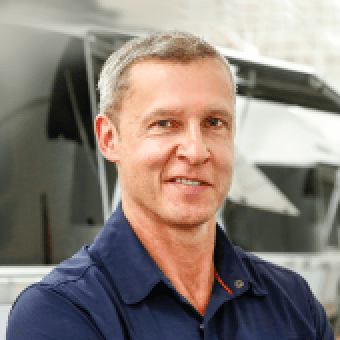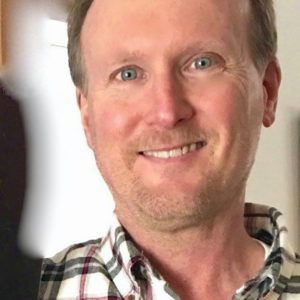‘Always Go To Them’


Few products have been so unchanging in their outer form as Airstream trailers, whose now-iconic “silver bullet,” riveted-aluminum shell has remained basically the same since Wally Byam put together his first Airstreams and began selling them in the early 1930s.
But by changing what’s in, above and around the basic shape, Airstream has continually freshened its product line for the most discriminating class of customers in the recreational-vehicle market. And as they came out of the pandemic, those customers were demanding Airstream make it easier for them to perform white-collar work out of their trailers.
That’s how the company came up with the Flying Cloud Office, a 30-foot version launched in early 2021 that features a dedicated office space with a wide desk, multiple USB ports, sliding drawers and cubbies, an overhead dry-erase board, a comfortable swivel chair and securing strap, a chair mat, blackout curtains and a divider that deadens sound from the rest of the trailer.
Airstream didn’t just figure out the Flying Cloud Office by osmosis: It relied heavily on input from hundreds of customers through formal relationships, as well as heavy communication via dealers, social media and one-on-one outreach to owners of Airstreams whose price tags can push $200,000.

“These conversations were an important part of developing the Flying Cloud Office because they provided valuable insights into how our products were being used out in the wild,” says Airstream CEO Bob Wheeler. “Going forward, they’ll provide important perspectives on big issues like towing, power and electrification, resource availability and conservation.”
Indeed, customer feedback on products is probably the most important discussion going on right now at Airstream. “We’ve been delivered an enormous group of new customers that we wouldn’t have seen otherwise,” Wheeler concedes. “So, how do we make sure we don’t squander this opportunity? We’ve been redoubling product development on top of increasing manufacturing capacity.”
For most CEOs, product development has become more strategic in a new environment ripe with post-Covid opportunities, riven by difficulties in supply components for existing products, demanding of accelerated digital transformation—and yet fraught with penalties for missteps at such a fateful crossroads. Only continued product innovation keeps companies in lockstep with their customers and crucial steps ahead of their competitors.
Chief Executive talked with dozens of CEOs, product-development chiefs, industry consultants and others to glean insights about the elements of product-development success for the new era. Here are some strategies they shared:

“Tapping into your customer relationships and gathering their detailed, firsthand input about individual challenges—and then solving for them specifically—is a surefire way to ensure you’re delivering a meaningful product,” says Barry Conlon, CEO of Overhaul, a supply-chain technology provider based in Austin, Texas.
It’s an approach that United Wholesale Mortgage founder Mat Ishbia also used in developing the technology-based products his company uses to help mortgage brokers satisfy home buyers better than banks and other retail lenders. Brokers were telling him they wanted to make the application and approval process “faster, easier and cheaper,” says the CEO of the Pontiac, Michigan-based U.S.-industry leader in wholesale mortgages.
“I thought about what was the best thing for our clients, and the business would follow,” Ishbia says. So a few years ago, the company built a technology platform called YouClose that gives brokers the digital levers to close a loan within 15 minutes instead of the traditional days or weeks. “No one has come close to duplicating it.”
CEOs can systematize the process of garnering product insights and ideas from customers. For example, members of the executive-leadership team of Kaseya, a management-software company, call customers daily to get a “pulse check on what’s working and where we need to pivot to improve,” says Fred Voccola, Kaseya’s CEO. “This guides our product roadmap to ensure that we aren’t just looking for the ‘cool new feature.’”
Airstream established its Airstream Customer Council in 2019 and adapted 21 product and customer-experience improvements recommended by the group in the first year. For its annual reseating in 2021, Airstream had 800 applications and selected 15 owners, more than half of whom had been “Airstreamers” for a year or less. For the Flying Cloud office, “we didn’t just talk with them about functionality but also about things like the importance of privacy in such a configuration,” says McKay Featherstone, Airstream’s vice president of product development and engineering. “We can always go to them.”

Sunny Sanwar, CEO of Dynamhex Technologies, says “companies should be detectives, piecing together disparate clues to figure out what customers might do next.” The chief of the provider of energy-consumption and carbon-footprint data based in Kansas City cautions against “development sprints to get a shiny object out the door. Capture the experience of potential customers—or lack thereof—and create something that the status quo can’t keep up with.”
For job search site College Recruiter, reading customers meant coming up with a new product line that charged employers for how many candidates were being brought to them by the company’s job postings instead of being charged for the number and duration of position listings. “We thought at first that it was just a different way of pricing the same product, but our customers showed us that it really was a different product,” says Steven Rothberg, president and founder. “Our employees needed to make a whole bunch of new mathematical calculations intuitively and then communicate that to a [customer] who’s not good at math and just wants to know how much it costs.”
With a nod to Simon Sinek, Julie Guest says the first question in developing any new product is, “Why do we need this innovation?” says the CEO and chief marketing strategist for marketing agency Bolder&Louder. “Once you know the ‘why,’ now you can be laser-focused about the ‘what’ and ‘how.’”
For Mark Herrema, the “why” was because he wanted Newlight Technologies to help solve climate change. The cofounder and CEO graduated from Princeton University in 2004 with a determination to harness ocean microorganisms that eat greenhouse gases and make industrial ingredients out of them. “If we could do that,” Herrema says, “we could create a consumer-driven pathway to healing the environment.”
So Herrema’s startup spent a decade developing a biodegradable white carbon powder he called AirCarbon that could be melted and used as a substitute for plastic, revealing it to the world in 2013 just as global concerns about waste plastics were mounting. “We had outreach from many brands,” he recalls, “but we knew that most [plastic wastes] accumulating in the ocean were related to food and foodware. So we decided to focus there.”
And recently, Newlight’s Restore brand of AirCarbon disposable straws and cutlery debuted in Target stores, just as millions of American consumers are looking for environmentally friendly foodware products. Next up: a wider variety of foodware products and a diversification into AirCarbon-based handbags, wallets and eyewear.
Eric Sklar began ideating a broader product purview for NuStep in 2018, soon after he took the helm of the Ann Arbor, Michigan-based maker of “recumbent cross-trainers” for rehabilitation from heart surgery. “I wanted to identify what value the company brings,” he says. “Before I joined, they thought of themselves as a recumbent-training company, and now I feel we’re an ‘inclusive’ company building inclusive equipment that our customers have been expecting from us.”

In practice, this means NuStep is broadening applications for its machines to aim them at new customers and new markets, such as orthopedic-surgery patients. “We’re setting the foundation for having to change and never sitting still,” Skylar says.
Live Real Farms is a new beverage brand launched by Dairy Farmers of America after the farmer-owned cooperative saw American consumers sprint into plant-based milk analogs. After decades of decline, the dairy industry can ill afford much further leakage in consumption of fluid milk.
Milk + Almond is the nation’s first “hybrid” offering that blends milk with plant ingredients. “As we saw the ‘flexitarian’ trend grow, it was important from our perspective to find ways to deliver modern beverages that get dairy to consumers,” says Rachel Kyllo, senior vice president of marketing and innovation for dairy brands for the Kansas City-based outfit. “We believed this could be the best of both worlds, coming together in one product.”
Levenger literally examines desktops for physical spaces where it can fit new products in its lineup of fountain pens, notebooks, quality paper, briefcases and so on. “You think of the ecosystem of the desk and a share of the desk, not the wallet,” says CEO Margaret Moraskie. “There’s still a need for new products even after we’ve become so technologically advanced. Right now, people are paying big money for digital detox.”
The search has even taken the company back to its archives for defunct products that might resonate with consumers who are increasingly oriented to home offices. Among them: book weights and copper page nibs “that are great for homeschooling,” Moraskie says. Levenger also is bringing back an old-school portable lap-desk and improving it by putting tuckaway legs on it.
Enzymedica continually looks at gaps in the consumer lineup it can plug with new supplements, focusing on specific markets such as heartburn products.
“There was white space there because OTC and prescription drug products have histories of side effects for long-term usage,” says CEO Scott Sensenbrenner. “The category needed immediate benefits and zero side effects with a natural product.”
So Enzymedica partnered with the Roskamp Institute, a medical-research organization in Sarasota, Florida, to develop such a supplement with ingredients that include a type of seaweed that “has a very unique, protective effect that works very rapidly in the body,” Sensenbrenner explains.
In the technology business, says Dean Guida, founder and CEO of software outfit Infragistics, there are three ways to find unoccupied nooks and crannies and even somehow wide-open, unexplored market opportunities. One is to understand products already in the market “and identify patterns where the competition really isn’t solving the problem,” he says. Another is to “see a better way to solve the problem that will give you a clear competitive advantage.”
A third path to finding white space is to “see a big platform vendor and product in the market and add value on top of it. That’s the fastest path to revenue, but it also doesn’t sustain revenues or have a long life cycle because every time a vendor releases a new product, you’re shaking in your boots.”
The digital imperative is transforming product development, and CEOs need to keep this top of mind. Ford CEO Jim Farley was doing exactly that in May when he told investors the traditional automaker is transitioning to a technology-driven growth company behind new features such as over-the-air software updates. “This is our biggest opportunity for growth and value creation since Henry Ford started to scale the Model T, and we’re grabbing it with both hands,” Farley said.
That approach is consistent with Dave Sovie’s advice. “Traditional hardware-oriented products were historically about mechanical engineering,” says the senior managing director for Accenture consultants and author of the book, Reinventing the Product. “Today, the product is smart and connected and AI-powered and much more driven by software and data. For the CEO, that means thinking through the product roadmap, and the product is a platform that is upgraded over time.”
The next logical step in that thinking is, “if a product is smart and connected, why sell it just as a product? Why not sell it as a service? Also, Wall Street gives higher business valuations to recurring-subscription models than to transaction models,” Sovie says.
Embrace Iteration
Forego “big-bang launches once a year in favor of more continuous innovation with agile engineering,” Sovie advises. Kryon Systems takes such an approach with its robotic process-automation software that, for example, has helped customer Wyndham Hotels identify and map processes for onboarding new properties. When the Tel Aviv-based company introduced its newest software platform, called Discover, Kryon “released it to market sooner than others might have because it wasn’t perfect,” says CEO Harel Tayeb.
“Instead of waiting for something that was bulletproof, we took it to market, released it, and every month, with very small iterations, we release an update for this product,” Tayeb explains. “That makes it much more valuable for our customers. We use the market as a lab.”
Brother Mobile Solutions is confident its upcoming new hardware platform will be a big hit because its label-printing technology will offer a blockchain solution for greater security of supply chains and will integrate not only with ERP systems, such as SAP and Oracle, but also with increasingly popular warehouse-management systems such as Blue Yonder.
But the new platform came from the company’s approach that favors constantly putting players “on base” with “singles” rather than trying to hit a home run every time at bat. “There’s big focus on generating ideas and then nurturing a portfolio of those ideas that we think will work, but not necessarily making a huge bet on any of them,” says David Crist, president of the Broomfield, Colorado-based arm of Japan’s Brother International. “We score them and gradually, incrementally invest in the best and make it the next product to be developed.”
Get the Structure Right
Abandon the siloed approach to product development in favor of multidisciplinary teams. “Leading CEOs are combining people who know the customer experience and user interface with hardware engineers and software engineers with services people who understand how the product is used in the field,” Sovie says.
Give your people some freedom. “If you as CEO set the goal and the vision and direction and let teams and people come up with the how-to-get-there, they think of a lot of interesting and better ways,” Guida says. “Giving them autonomy to execute facilitates innovation in new products and processes.”
For that reason, in fact, Cranbury, New Jersey-based Infragistics recently launched a $50 million innovation lab that will fund internal inventors to experiment with innovations beyond the company’s core user-interface and user-experience products “without an immediate need to generate immediate revenue,” the company says.
Jeff Beck, president and CEO of Leaf Home Solutions, has brought all product-development efforts in-house during his seven years at the top of the maker of gutter-protection systems and other home-maintenance products, even though he has steadfastly kept all manufacturing outside on a contract basis.
“That way we get 100 percent effort all the time in product development,” Beck says. “If you outsource, they’ll do what you want, but it just takes too long.” The $1.1 billion company based in Hudson, Ohio, is in the midst of a new-product push that includes not only larger, California-style gutter covers but also walk-in tubs, shower bases and stairlifts. “We built a team that is forward-thinking and agile.”
Indeed, for many CEOs, seating themselves atop the product-development pyramid is an important part of the structure of the function. Christine Specht, for example, personally decides on any iterations to the submarine sandwiches and other products that her family-owned chain, Cousins Submarines, has made regionally famous in Wisconsin and Illinois.
“Nothing is on the menu that hasn’t come across me, because I want to make sure it fits what we’re doing,” says CEO Specht. “We have adventurous consumers who want to give something else a try. But we recently tested a number of different plant-based options for sausages and meatballs, and they just didn’t quite fit what our focus is. We’re probably not going ahead anytime soon with something that’s specifically meant to look and taste like meat—‘but it’s a plant.’”


0

1:00 - 5:00 pm
Over 70% of Executives Surveyed Agree: Many Strategic Planning Efforts Lack Systematic Approach Tips for Enhancing Your Strategic Planning Process
Executives expressed frustration with their current strategic planning process. Issues include:
Steve Rutan and Denise Harrison have put together an afternoon workshop that will provide the tools you need to address these concerns. They have worked with hundreds of executives to develop a systematic approach that will enable your team to make better decisions during strategic planning. Steve and Denise will walk you through exercises for prioritizing your lists and steps that will reset and reinvigorate your process. This will be a hands-on workshop that will enable you to think about your business as you use the tools that are being presented. If you are ready for a Strategic Planning tune-up, select this workshop in your registration form. The additional fee of $695 will be added to your total.

2:00 - 5:00 pm
Female leaders face the same issues all leaders do, but they often face additional challenges too. In this peer session, we will facilitate a discussion of best practices and how to overcome common barriers to help women leaders be more effective within and outside their organizations.
Limited space available.

10:30 - 5:00 pm
General’s Retreat at Hermitage Golf Course
Sponsored by UBS
General’s Retreat, built in 1986 with architect Gary Roger Baird, has been voted the “Best Golf Course in Nashville” and is a “must play” when visiting the Nashville, Tennessee area. With the beautiful setting along the Cumberland River, golfers of all capabilities will thoroughly enjoy the golf, scenery and hospitality.
The golf outing fee includes transportation to and from the hotel, greens/cart fees, use of practice facilities, and boxed lunch. The bus will leave the hotel at 10:30 am for a noon shotgun start and return to the hotel after the cocktail reception following the completion of the round.